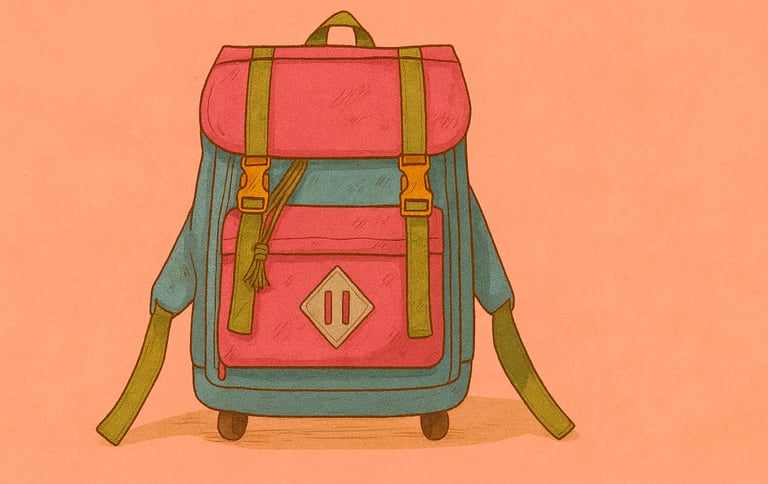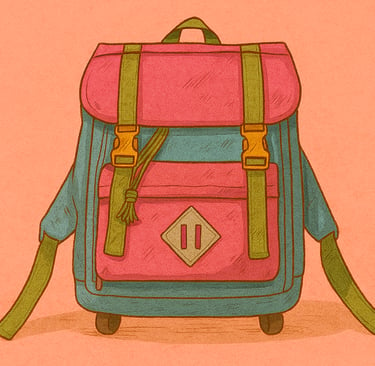Backpacks for Kids: What to Look For (and What to Avoid)
Find the best backpack for your child with this guide — from size and fit to safety and durability. Plus, our top picks by age group.
GEAR REVIEWS
🎒 Backpacks for Kids: What to Look For (and What to Avoid)
Find the best backpack for your child with this guide — from size and fit to safety and durability. Plus, our top picks by age group.
Choosing the right backpack for your child can feel surprisingly complicated. Between endless styles, characters, and features, it’s easy to focus on what looks fun rather than what actually supports your kid’s comfort and health. The truth is — a backpack isn’t just another school or travel item. It’s something your child will use every day, and the wrong one can cause back or shoulder strain, messy packing habits, or simply frustration.
This guide explains what to look for (and avoid) when choosing a backpack for kids — whether it’s for school, travel, or weekend adventures — plus a few tried-and-tested examples by age.
🧭 Key Features to Look For
1. Proper Fit and Size
A child’s backpack should not be larger than their torso.
Preschool & Kindergarten: 10–14 inches tall, under 10L.
Elementary (ages 6–9): 14–16 inches tall, 12–18L.
Preteen & Older (10–13): 16–18 inches, up to 25L.
Tip: The bottom of the backpack should rest no more than 2 inches below your child’s waistline. Adjustable shoulder straps and a sternum clip help keep weight evenly distributed.
2. Comfortable Padding
Look for padded shoulder straps and a breathable back panel. These reduce pressure and prevent sweating during long school days or family trips.
Avoid: thin straps that dig into shoulders — they cause discomfort and uneven load distribution.
3. Lightweight and Durable Materials
Choose nylon, polyester, or ripstop fabrics that can handle daily wear, spills, and playground adventures.
Water-resistant coatings are a big plus for travel and rainy days.
Avoid: PVC materials — they’re heavier, less flexible, and not environmentally friendly.
4. Smart Organization
The best backpacks teach kids how to organize.
Look for:
A main compartment for books or clothes
A front pocket for small items
Side pockets for bottles
A name tag slot (useful in schools and airports)
Avoid: Too many zippers or hidden compartments — they just add bulk and confusion.
5. Reflective Details for Safety
If your child walks or bikes to school, reflective strips can make a big difference in visibility, especially during winter mornings.
Avoid: All-black or dark designs without reflective patches unless you add a safety clip-on light.
🚫 Common Mistakes Parents Make
Buying for “growth”: A large bag that your child “will grow into” is usually too heavy and awkward now.
Ignoring weight: The backpack (when full) should not exceed 10–15% of the child’s body weight.
Prioritizing design over ergonomics: Superhero prints are great, but comfort and structure matter more.
Skipping quality: Cheap zippers or weak seams will fail fast — and you’ll end up buying twice.
🧒 Recommended Backpacks by Age Group
These aren’t sponsored — just examples that match what we recommend for travel and school comfort.
🎈 Ages 3–5: Skip Hop Zoo Mini Backpack
Lightweight (under 300g)
Padded straps and easy-to-open zippers
Fun animal designs kids love
Perfect for daycare, preschool, or short family trips.
🏫 Ages 6–9: Deuter Kikki or Fjällräven Kånken Kids
Ergonomic design with chest strap
Reflective details and eco-friendly materials
Compact yet spacious for books and snacks
Ideal for early school years or weekend outings.
🏕️ Ages 10–13: Osprey Jet 18 or REI Tarn 18
Real hiking-style support system
Adjustable harness for growing kids
Great for travel, school, or outdoor adventures
Lightweight yet rugged — perfect for family trips abroad.
✈️ Bonus: Travel-Ready Backpack Checklist
Before you buy, make sure the backpack:
✅ Fits your child’s back length
✅ Has adjustable padded straps
✅ Includes at least one reflective patch
✅ Weighs under 700g empty
✅ Can stand up on its own (helps with airport and classroom chaos)
💡 Final Thoughts
A backpack isn’t just storage — it’s a daily companion for your child’s comfort, confidence, and independence. Invest in something ergonomic, light, and durable. Your child will thank you every morning when they lift it with a smile instead of a sigh.


💬 FAQ: Backpacks for Kids
1. What size backpack should I buy for my child?
Choose a backpack that matches your child’s torso length. For preschoolers, under 10 L is best; for ages 6-9, look for 12-18 L; and for 10-13 year olds, up to 25 L. The bottom of the pack should sit no lower than 2 inches below the waistline.
2. How heavy should my child’s backpack be?
A full backpack should not exceed 10–15 % of your child’s body weight. If your 20 kg child’s bag weighs 4 kg—it’s too heavy. Remove books or switch to lighter materials.
3. Which is better — a hard-shell or soft-shell backpack?
For everyday school or travel, soft-shell backpacks made from nylon or polyester are lighter, easier to pack, and more comfortable. Hard-shell packs are better for hiking or protecting electronics.
4. What materials are safest and most durable?
Opt for ripstop nylon or recycled polyester with water-resistant coatings. Avoid PVC or vinyl—they’re heavier, less flexible, and less eco-friendly.
5. How often should I replace a child’s backpack?
Typically every 1–2 years, depending on growth and wear. Replace sooner if straps fray, zippers break, or the bag no longer fits comfortably.
Smart Tips for Choosing and Using Kids’ Backpacks
🎒 Try before you buy: Have your child wear the backpack with some weight inside. It should feel snug—not swinging.
⚖️ Weigh it weekly: Kids add “extras” (stones, toys, entire collections). Keep an eye on total load.
🧵 Check stitching: Reinforced seams around straps and zippers mean longer life.
💧 Add a name tag: Especially for school or travel—no more lost bags at the airport carousel.
🌈 Let kids choose the design: When they like the look, they’re more likely to carry it properly.
🚶 Use both straps: One-shoulder carrying looks cool but strains the back.
☀️ Keep it visible: Choose bright colors or reflective elements for safety in low light.
🧽 Clean regularly: A quick wipe every week prevents buildup of crumbs and mystery stickiness.
🏷️ Teach organization early: Use pockets for categories—books, snacks, “treasures.”
🌍 Think sustainable: Some brands use recycled bottles or eco fabrics—better for the planet your kids will travel in.


